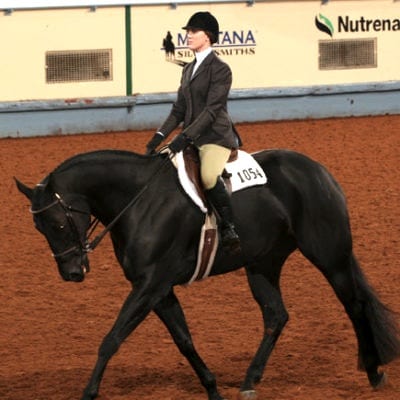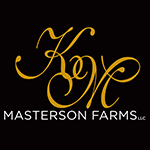The hunt seat equitation class, per the AQHA Rulebook, is one that was “designed for a hunter rider to showcase the ability of both horse and rider through various maneuvers on the flat that lead to a natural progression to classes over fences.”
Even though this is clearly stated in the rulebook, riders seem to forget this is the point of the class. There are many common mistakes that judges are consistently seeing that are affecting exhibitor’s scores.
GoHorseShow sat down with AQHA Professional Horsewoman, Sandra Vaughn, of Ocala, Florida to give exhibitors ten quick tips on how to raise their hunt seat equitation scores. Vaughn’s seeks to impress upon exhibitors how to ride the class like a Hunter and not a western rider who just happens to be sitting in an English saddle. Take notes!
1) Learn How to Two-Point Correctly
“The term two-point means you have two points of contact. That contact should be with your legs, not your feet,” Vaughn said. “So many riders use their feet to get up out of the saddle and don’t have the connection with their legs.”
For a two-point to be correct, Vaughn explained that the rider needs to maintain contact with the horse with each leg, push out their rear end, keep their groin behind the pommel, and keep their shoulders over their hips.
“It needs to have a nice, soft look to it,” she said. “Riders should use their core and lower back to help carry them through the two-point position in addition to maintaining contact with their legs.”
2) Hand Gallops Require a Change in Gait
“The hand gallop needs to become another gait,” said Vaughn. “This doesn’t mean going faster, but allowing the horse to lengthen their stride and cover more ground.”
Vaughn suggests practicing a hand-gallop regularly at home just as you would the walk, trot, and canter. As she said, it is another gait and should be treated as such.
In addition to changing gait, when a rider moves into a hand gallop they should shorten their reins and slide into a two-point gracefully.
Vaughn said, “Please don’t creep up the reins with your fingers either. The traditional, proper way to shorten your reins is to bridge and then shorten.”
Good riders should be able to do this maneuver without it looking sloppy or unfinished. Grand Prix riders, for example, do not creep up their reins. It is not only improper, it can be dangerous in the chance that a wreck occurs and your fingers are loose around those reins. Bad news.
3) This is Not Pleasure, Stop Having Loose Reins
Speaking of reins, one of the biggest pet peeves judges have of riders in hunt seat equitation is that their reins are too long or too loose.
“Always be connected to your horse,” said Vaughn. “You can’t be connected with your horse if your reins are too long. True connection is through your legs up through to your hands. This does not mean pulling on your horse’s mouth either. It has nothing to do with pulling, it has to do with feel.”
We’ll cover more on feel later.
4) Stop With the Long Irons, Too
Vaughn pointed out that over time the left iron leather eventually stretches out because that’s the side we mount on and riders should be aware of this each time they ride.
“Even doesn’t necessarily mean the same number (of holes) on each leather,” she said. “So, change out the iron leathers occasionally, and make sure the top of the iron itself is even with your ankle bone. You also want to adjust accordingly based on how someone is built.”
5) While We’re At It, Let’s Talk Leg Position
Since we are on the topic, so many riders don’t maintain a proper leg position in the hunt seat equitation.
Vaughn said, “Your thigh should not be pointing to the horse’s eye or nose and your entire leg should resemble a backward letter Z. We want to see your legs wrapped around the horse and the iron and leg should stay about the middle of the girth. A lot of folks tuck into the knee rolls on their saddle too, and when they do this, the rest of your leg is too far off the horse. Very few can tuck into the knee rolls and maintain a connection with their lower leg, so it’s usually best to avoid doing that.”
6) … And Hand Position
Don’t have tragic hands.
Biggest no-nos? “Puppy paws,” (broken wrists) and having your thumbs pointing toward the sky. Please, just stop.
“Your hands should be about two inches apart and above the withers,” said Vaughn. “Your left hand should point at about 2 o’clock and your right should be pointing at about 11 o’clock. Your hands are meant to be connected in a straight line from the horse’s mouth to your wrist to your elbow.”
Remember, connection folks, it’s the name of the game.
7) Proper Posture is Proper
Vaughn said that a lot of issues with a rider’s posture can be addressed and/or corrected by adjusting the iron length properly, but that ultimately, the main thing to keep in mind is that your shoulder, hip, and heel should be one continuous line.
“I don’t like to see rigid and stiff postures either,” she said. “Your posture should be supple and soft.”
Like people tucking into their knee rolls and losing connection with their leg, Vaughn also cautioned against having a more forward posture which more closely resembles “true” hunters.
So if it is more “true” to the hunter style, why avoid it?
“A lot of people cannot maintain their balance with a more forward posture, and it just throws everything off,” she said.
Stick to the basics; shoulder, hip, and heel equal one continuous line and you’ll be ready to go.
8) Diagonals. Learn Them.
In order to learn your diagonals and pick them up correctly every single time, you have to learn foot fall. You have to be aware of which leg is striking the ground and when.
Vaughn said, “In a perfect world, everyone would know their diagonals and be able to pick them up without a problem. Obviously, this is not the case, so if you are one of those people who has trouble picking it up, use your peripheral vision to see where the leg is and if you must, drop your eye. But, if the brim of your cap tilts down, even a little bit, be aware that it will count against you.”
Author’s Note: For more on diagonals and how to learn them, check out this story.
9) Know What Feel Is and How to Use It
Vaughn shared an amazing analogy with us about a great way to teach a rider about feel.
She said, “Take your hand and place it around someone’s wrist. Then gradually tighten it. Eventually, their hand will go numb. As you loosen your grip, the feeling will come back.”
The point of this exercise is to show that feel is not about tightness and rigidity. Even with your hand softly around a person’s hand, you have connection and control. This is what feel is.
“Feel is all about being connected and in control without micromanaging or being overbearing,” said Vaughn. “You need to learn to ride your horse in a forward step without doing this. Feel requires a softness that still maintains the connection and control.”
10) Know What Balance Is and How to Maintain It
In order for a rider to maintain their balance in the saddle, they have to know how a horse’s energy flows and how to balance themselves with it.
Vaughn said, “A horse’s energy comes from the hindquarters, through his spinal column, to his neck, and out of his head.”
This being said, in order for you to maintain proper balance you need to be a unit with your horse, meaning you don’t get ahead or behind his movement. If you do, you are out of balance, out of sync, and your score will plummet. Know how your horse moves and stay right with him, and your marks will surely be higher.
Summary
Like any other class, hunt seat equitation is one that requires practice and loads of finesse in order to be competitive. Vaughn said the main thing to remember is to not be mechanical and that a rider and a horse need to execute the pattern in a flowing and pretty way in order to be in the blues.









